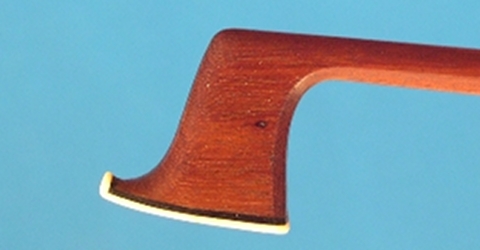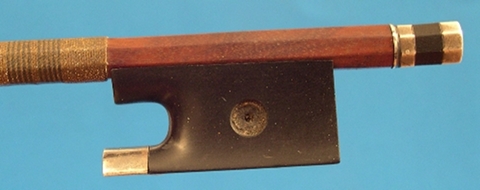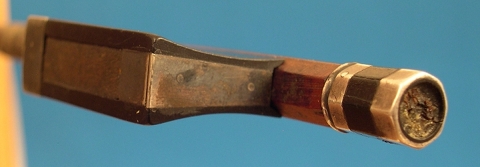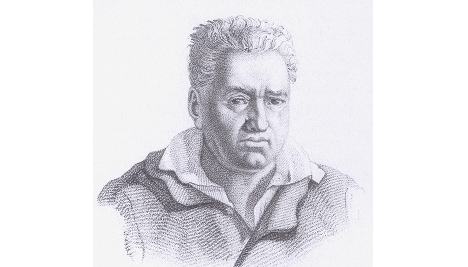LE JEUNEA few years ago, Pierre Guillaume told me that the best time in the professional life of a bowmaker is that one going from thirty to forty-five years. After this age, in his opinion, the eyes and hands of the craftsmen, begin a slow but inexorable decline, affecting their bows as well. From my personal experience I can say that I know at least one of them who is now even more than fifty but has a very high level of construction, even better than when he was thirty. But to think that the bow you see below was built by a person older than seventy years , induce to believe seriously in extraterrestrials! Head violin bow by F.X. Tourte When you look at the work of Francois Xavier Tourte, "The Stradivarius of the bow, " or more simply Tourte "Le Jeune", you are amazed by the huge and rapid mechanical and style development of the bows built by him and you hardly realizes that , as you progress, the hand, in addition to the style continues to evolve and refine. Think that the "golden age" of this master is placed between his sixty and seventy-seven years ! This is the age when he built what accordingly to Millant and Raffin, is considered his most beautiful bow ( see Millant and Raffin - L'Archet). History In the late '60s, some years after the supervening death of his father, he leaves his job as a watchmaker and begins to help his brother, building the mechanical parts of the bows enjoying the experience gained in his previous work. In 1774, Francois begins to build bows with his brother, soon equaling and exceeding his brother's skill. Exactly in these years he will have a lucky encounter with Giovanni Battista Viotti, who will help to develop the modern bow. The collaboration with his brother broke off shortly after the revolution about in the year 1791. Nicolas Leonard, guilty of having fraternized a little bit too much with the French aristocracy, was persecuted, like Viotti, who was forced to flee from Paris, by the children of the revolution until 1807, when all traces of him disappeared (or was made to disappear; who knows ?). In 1791, when the Corporations were abolished, Francois Xavier finally opened his business and he will continue to build until his death probably occurred in 1835 . The mechanics
At first, he dedicated himself to refine the mechanism of the frog. Thanks to his knowledge he developed the mechanism of screw and nut, the button turned from a mere ivory knob to the most articulate and complicated one to be built as a "three- part ", in ebony, silver and mother-of-pearl. Three-part button Slide, knee and ring Pernambuco wood has exceptional qualities, and exactly for this reason, it was necessary to find a curve model that was able to control its power. And even if later it will be called " Peccatte Curve" ( see Softness and stiffness) it was actually developed by Tourte. Style If I could show you all pictures of the bows as published by Raffin in his wonderful book "L' Archet" you would realize what I say. The first Tourte's bows are in the so called "Cramer" model, the same one used by his brother. The head with the throat falling backwards and a primitive mechanism of the frog with flat slide while proceeding we meet the future Adam, Maline, Peccatte, etc. practically until Sartory. The character When you are in front of craftsmen of this level,observing their works, one gets the impression to know them a little bit more Both from the mechanical and aesthetic point of view Tourte's bows recall a feeling of austere seriousness. The lines of heads and frogs are not always perfect , echoing probably a not too friendly personality , but a determined and authoritarian one. It is precisely those imperfections, which adorn the head that the impetuous Tourte comes out . A bit like the curls by Guarnieri del Gesù, which are horrendous, but the more you look at them, the more you like them and you will not be able to watch that violin with an aesthetically perfect head. The same thing can be said of the sticks. The octagonal, contrary to the heads, is perfect, even after seventy years. I have never such a level of work in any other author, also considering that the tools were not like those used nowadays. We also have to consider the quality of wood. If you could see his production you will see that the criteria used to select the material follow some parameters that are completely different from those of his time. Pernambuco wood was and is very different from those used at that time. By nature, it does not have a a soft tone as Snake wood, for instance, so many craftsmen , even if they used it, were trying to get similar tones making bows with dense and dark material , but ninety-nine times out of hundred it did not played . One of the most significant examples is Lamy, whose favorite wood is very dark and heavy, with soft but not effective tone, I never found a Lamy that could play. This is felt even in the aesthetic heads and frog by this author, they are beautiful and perfectly executed, but a little dull. The wood used by Tourte is rather varied. Sometimes it is dark, others one clear, others again light or dense, but the characteristic sound of Tourte is very uniform. Round sound from heel to toe, powerful and running. I was lucky enough to have in my hands four Tourtes's bows , including the one displayed in this photo, and all, I say all, were still perfectly working. Considering the age of these masterpieces, this thing is truly miraculous. When I took the pictures to the Tourte's bow you see, it was not the only one , but it was a part of a collection of twenty-two bows among the greatest ones : Peccatte, Maline, Adam, etc. .. You will not believe it, the only one that was still playable was the Tourte's bow. The oldest of all. As I said at the beginning, an Alien! So long. Paolo.
|
   |











